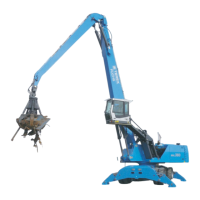2 SAFETY AND ACCIDENT PREVENTION
2.6 MHL380 D
2.2.6 Safe working with the machine
The values in the carrying capacity tables
must be strictly observed and must not be
exceeded.
Before starting work, familiarize yourself with
the specific features of the site of operation,
specific requirements and warning signals.
The working environment includes, for
example, obstructions in the working area,
the load bearing capacity of the ground and
requirements to close the site off to public
traffic.
Always maintain an adequate safety
distance from overhangs, edges,
embankments and unsafe ground.
Be particularly attentive if visibility is poor
and soil conditions vary.
Familiarize yourself with the location of
supply lines at the site of operation and be
particularly careful when working close to
them. If necessary, inform the relevant
authorities.
Keep the machine at an adequate distance
from overhead electrical lines. When
working in the vicinity of overhead electrical
lines, do not move the loading equipment
close to the lines. Risk of fatal injuries! Find
out what the applicable safety distances are.
In the event of electrical current jumping
from a line to the machine, proceed as
follows:
- do not perform any movements with the
machine or its loading equipment,
- do not leave the cab,
- warn persons outside not to approach or
touch the machine,
- have the electricity turned off.
Before moving the machine, always check
that accessories are positioned so they will
not cause an accident.
Always turn on the light when visibility is
poor or it is dark.
Do not allow any passengers on the
machine.
Always be seated with the safety belt
fastened while working.
Report all operating faults and make certain
all necessary repairs are performed
immediately.
Personally ensure that setting the machine
in motion will not put anyone in danger.
Before starting work, check the brake
system according to the requirements in the
operating instructions.
Never leave the operator's seat while the
machine is in motion.
Never leave the machine unattended with
the diesel engine running.
The machine must be used, driven and
operated in such a way that it is always
stable and not at risk from overturning.
Loading equipment must only be used with
known loads, especially in grab operation.
The maximum permissible incline/transverse
inclination that the machine can traverse
depends on the ground and the attached
equipment.
Adjust the travel speed to on-site conditions.
Avoid operational movements that could
cause the machine to tip over.
If possible, always work facing uphill or
downhill and never sideways to the incline.
Drive downhill only at the lowest travel
speed. Otherwise you risk losing control of
the machine.
Drive downhill only at a low travel speed.
Otherwise you risk losing control of the
machine. The diesel engine must be running
at maximum speed and the speed must be
reduced by selecting the lower travel speed
range.
Safe
working
with the
machin

